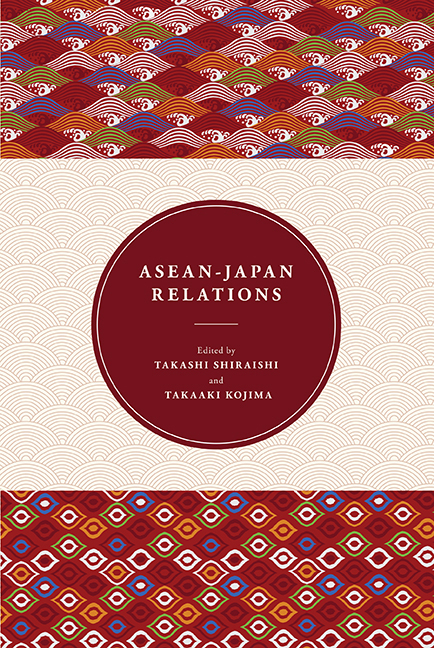Book contents
- Frontmatter
- Contents
- Preface
- About the Contributors
- 1 An Overview of Japan-ASEAN Relations
- 2 Japan's Relations with ASEAN
- 3 Approaches toward Regionalism: Japan, China and the Implications on ASEAN
- 4 The New Japan-ASEAN Partnership: Challenges in the Transformation of the Regional Context in East Asia
- 5 ASEAN-Japan Strategic Partnership and Regional Integration: Impacts and Implications
- 6 ASEAN-Japan Cooperation on Maritime Non-Traditional Security Issues: Toward a New Paradigm
- 7 Japan's Evolving Security Concerns in Maritime Southeast Asia: From Safety of Navigation to “Lake Beijing”
- 8 Evolution of Institutions and Policies for Economic Integration in East Asia: The Rise of China and Changes in the Regional Order
- 9 Managing Integration in East Asia: Behind Border Issues in Japan-ASEAN Trade Agreements
- 10 Regional Financial Cooperation in East Asia: Development and Challenges
- 11 Japanese Development Assistance to ASEAN Countries
- 12 Japanese Foreign Direct Investment in the ASEAN-4 Countries
- 13 Japan's Triple Tsunami
- 14 ASEAN-Japan Relations: A Singapore Perspective
12 - Japanese Foreign Direct Investment in the ASEAN-4 Countries
Published online by Cambridge University Press: 21 October 2015
- Frontmatter
- Contents
- Preface
- About the Contributors
- 1 An Overview of Japan-ASEAN Relations
- 2 Japan's Relations with ASEAN
- 3 Approaches toward Regionalism: Japan, China and the Implications on ASEAN
- 4 The New Japan-ASEAN Partnership: Challenges in the Transformation of the Regional Context in East Asia
- 5 ASEAN-Japan Strategic Partnership and Regional Integration: Impacts and Implications
- 6 ASEAN-Japan Cooperation on Maritime Non-Traditional Security Issues: Toward a New Paradigm
- 7 Japan's Evolving Security Concerns in Maritime Southeast Asia: From Safety of Navigation to “Lake Beijing”
- 8 Evolution of Institutions and Policies for Economic Integration in East Asia: The Rise of China and Changes in the Regional Order
- 9 Managing Integration in East Asia: Behind Border Issues in Japan-ASEAN Trade Agreements
- 10 Regional Financial Cooperation in East Asia: Development and Challenges
- 11 Japanese Development Assistance to ASEAN Countries
- 12 Japanese Foreign Direct Investment in the ASEAN-4 Countries
- 13 Japan's Triple Tsunami
- 14 ASEAN-Japan Relations: A Singapore Perspective
Summary
INTRODUCTION
Indonesia, Malaysia, the Philippines, and Thailand or the IMPT countries are usually referred to as the ASEAN-4 countries. Japanese foreign direct investment (FDI) in the ASEAN-4 countries has evolved through various stages after the post-World War II period. The Cold War saw the Japanese not being involved in the ASEAN-4 countries in an active manner, as they were not interested in war or in containing communism in Southeast Asia as were the Americans. In the 1950s and 1960s, the focus of the Japanese government's policy was to encourage direct investments to secure reliable flows of raw materials (Guisinger 1991, p. 30). From the late 1950s, the ASEAN economies were also becoming increasingly involved in import substitution industrialization (ISI) and there was little scope for Japanese direct investments in ASEAN. Japanese electrical products and cars were, however, sold in ASEAN countries.
The oil shocks in the early and late 1970s also saw increased Japanese investments in oil drilling in Indonesia to secure reliable supplies of oil for home consumption. There were Japanese investments also in textiles, chemicals, and metals in the ASEAN-4 countries in the 1970s. It was the next phase of export-oriented industrialization in the ASEAN-4 countries, which coincided with the Plaza Accord of 1985, that saw the active involvement of Japanese multinational corporations (MNCs) as direct and greenfield investors in several of the ASEAN-4 countries. In the 1980s Japanese corporations began to focus their investments in food processing, machinery, electrical and electronics goods, and more technologically advanced products (Guisinger 1991, p. 30).
This active phase of Japanese FDI in the ASEAN-4 countries lasted for about a decade, when, as a result of the opening up of China, Japanese investors took their capital to China to take advantage of cheaper unskilled labor and to exploit the advantages of a relatively huge domestic market. There were also divestments by Japanese multinational corporations in some of the ASEAN-4 countries after the Asian Financial Crisis (AFC) of 1997–98. In divesting, the Japanese multinational corporations exhibited tendencies of being “footloose” and revealed their preference for commercialism over benevolence. The slowing down of Japanese investments in the ASEAN-4 countries also coincided with the AFC of 1997–98, the bursting of the Japanese bubble, the deflationary cycle in Japan, and the admission of China into the World Trade Organization (WTO) in 2001.
- Type
- Chapter
- Information
- ASEAN-Japan Relations , pp. 237 - 265Publisher: ISEAS–Yusof Ishak InstitutePrint publication year: 2013

